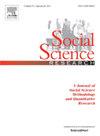国家资助的“替代堕胎”项目能降低堕胎率吗?纵向分析
IF 3.5
2区 社会学
Q1 SOCIOLOGY
引用次数: 0
摘要
在美国联邦政府保护堕胎权的时代,许多多数保守的州政府试图通过实施州级战略来反对堕胎。我研究了其中一种方法的影响:由税收资助的“堕胎替代方案”(A2A)项目,该项目表面上提供支持(/强迫)怀孕至足月的资源。我使用Meredith Worthen的以规范为中心的耻辱理论(NCST),一种越轨行为的社会学理论,来指导这些项目的分析,它们产生的社会政治环境,以及两者对州居民生育决策的潜在影响。我构建了一个州级社会政治因素的纵向面板数据集,包括A2A计划、其他反对堕胎的政策和年度堕胎率。使用混合线性回归,我估计了有和没有程序的状态之间以及状态内随时间的关联。结果显示,A2A计划与各州之间的堕胎率显著正相关。关于其他堕胎反对政策(堕胎提供者的目标法规)的结果好坏参半,一些陷阱法律与显著的、积极的州内效应相关,而其他法律则与负相关或不显著相关。这些发现表明,像A2A计划这样的道德主义国家的努力可能会适得其反,而不是减少堕胎。从NCST的角度来看,这样的策略可能会强化狭隘的、道德化的生殖规范,潜在地增加对不规范怀孕的耻辱感,使堕胎更加引人注目。我讨论了A2A计划和堕胎率之间的正相关关系如何反映了社会环境对生育决策的影响,对堕胎污名化的影响,以及旨在影响堕胎率的政策的理论后果。本文章由计算机程序翻译,如有差异,请以英文原文为准。
Do state-funded “Alternatives to Abortion” programs reduce abortion rates? A longitudinal analysis
During the era of federal protection of abortion rights in the U.S., many majority-conservative state governments sought to oppose abortion by implementing state-level strategies. I examine the impact of one such approach: tax-funded “Alternatives to Abortion” (A2A) programs, which ostensibly provide resources to support (/coerce) carrying a pregnancy to term. I use Meredith Worthen's Norm-Centered Stigma Theory (NCST), a sociological theory of deviance, to guide analysis of these programs, the sociopolitical environments in which they arise, and the potential effects of both on the reproductive decision making of state residents. I constructed a longitudinal panel dataset of state-level sociopolitical factors, including A2A programs, other abortion opposition policies, and annual abortion rates. Using hybrid linear regression, I estimated associations between states with and without programs as well as within states over time. Results show that A2A programs are significantly positively associated with abortion rates between states. Results regarding other abortion opposition policies (Targeted Regulations of Abortion Providers) were mixed, with some TRAP laws being associated with a significant, positive within-state effect while others were negatively or non-significantly associated. These findings suggest that, rather than reducing abortion, moralistic state efforts like A2A programs may backfire. Through the lens of NCST, such strategies may reinforce narrow, moralized reproductive norms, potentially increasing stigmas around non-normative pregnancies, making abortion more compelling. I discuss how the positive association between A2A programs and abortion rates reflects social contexts shaping reproductive decisions, implications for abortion stigmatization, and theoretical ramifications of policies that aim to affect abortion rates.
求助全文
通过发布文献求助,成功后即可免费获取论文全文。
去求助
来源期刊

Social Science Research
SOCIOLOGY-
CiteScore
4.30
自引率
4.00%
发文量
0
审稿时长
65 days
期刊介绍:
Social Science Research publishes papers devoted to quantitative social science research and methodology. The journal features articles that illustrate the use of quantitative methods in the empirical solution of substantive problems, and emphasizes those concerned with issues or methods that cut across traditional disciplinary lines. Special attention is given to methods that have been used by only one particular social science discipline, but that may have application to a broader range of areas.
 求助内容:
求助内容: 应助结果提醒方式:
应助结果提醒方式:


